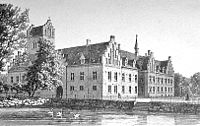Herlufsholm School
| Herlufsholm School and Estate Herlufsholm Skole og Gods |
|
|---|---|

The School in the late 19th century
|
|
| Address | |
|
Herlufsholm Allé 170 Næstved Denmark |
|
| Information | |
| Type | Private School |
| Established | 1565 |
| Founder | Herluf Trolle & Birgitte Gøye |
| Headmaster | Flemming Zachariasen |
| Grades | 6th to 12th |
| Gender | Mixed |
| Enrollment | 600 (approx.) |
| Houses | Mygningen, Vest, Øst, Vuen, Lassen, Egmont, PG, BG, Bodil |
| Colour(s) |
Blue & Silver (Trolle family) |
| Yearbook | Diple og Hørere |
| Website | Official Website |
Blue & Silver
(Gøye family)
Herlufsholm School and Estate (Danish: Herlufsholm Skole og Gods) is a private day and boarding school by the River Suså in Næstved, about 80 kilometers south of Copenhagen. Herlufsholm was founded in 1565 as a boarding school for "sons of noble and other honest men" by Birgitte Gøye and her husband Herluf Trolle on the site of a former Benedictine monastery from the 12th century.
Herlufsholm has been co-educational since the 1960s for day students, as of 1985 for boarding pupils, and is the only school in Denmark with a compulsory school uniform. The student body currently exceeds 600 students, of which approximately 275 students are boarders who lived in the dormitories. The pupils follow a 10-day programme with lessons on Saturdays followed by 3-day weekends. The school offers a range of education: from 6th grade in the Danish lower-secondary school; the optional 10th grade; the three grades in upper-secondary school, more commonly known as the STX; and the international programs: a preparatory class (1-2 year) with IGCSE exams and the International Baccalaureate Programme (I.B).
Herlufsholm is built on the site of a Benedictine monastery, founded in 1135, of which the church and a few other remnants are preserved and in daily use by the students and staff. The monastery was originally called Sct. Peder’s Monastery, but over the years it became known as Skovkloster (“The Forest Abbey"). It was seized by King Christian III of Denmark like all Catholic episcopal property during the Reformation in Denmark–Norway and Holstein in 1536. The king allowed the monks to remain, and the last monk left the monastery in 1559 in favour of another monastery in the close by city Sorø.
...
Wikipedia
